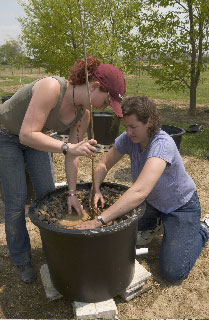Urban forestry researcher contributes to national report seeking public input on sustainable landscapes

Public comment is being sought on a new report that offers the most comprehensive set of voluntary, national guidelines ever developed for sustainable landscapes.
Susan Day, assistant professor of urban forestry and horticulture at Virginia Tech and a contributor to the report, said, "The Guidelines and Performance Benchmarks Draft 2008 includes more than 50 prerequisites and credit options for achieving sustainable landscapes. The guidelines cover everything from initial site selection and design to construction and maintenance."
More than three dozen technical advisors in hydrology, vegetation, soils, materials, and human health contributed thousands of hours to ensure the credits could apply to any landscape, with or without buildings. "The report is particularly timely because of increased concerns about such environmental issues as scarce resources, climate change, waste, and air and water pollution," Day noted.
Landscapes have the potential to use resources more efficiently, improve air and water quality, reduce the urban heat island effect, and remove carbon dioxide from the atmosphere -- helping reduce global warming. "Current standards addressing sustainable practices in the design and construction industry mostly focus on buildings rather than landscapes," explained Sarah Dickinson, a research associate in horticulture who worked with Day on the soils technical committee.
A recent consumer survey conducted by the American Society of Landscape Architects (ALSA) reflects this disparity. While only 58 percent surveyed said they used energy and resource saving practices in their yard, lawn, or garden, an overwhelming 96 percent used similar practices in their home.
The report was compiled by the Sustainable Sites Initiative, a partnership of the ASLA, the Lady Bird Johnson Wildflower Center at The University of Texas at Austin, and the United States Botanic Garden working in conjunction with a diverse group of stakeholder organizations to create a voluntary rating system for sustainable landscapes, large and small. View the report or submit comments, which will be accepted until the public comment period ends on Jan. 20, 2009. Responses will be integrated into the final report, scheduled for release in summer 2009.
The U.S. Green Building Council is lending its support to this project and anticipates incorporating the initiative metrics into future versions of the LEED (Leadership in Energy and Environmental Design) Green Building Rating System.
"The previous lack of comprehensive efforts to address sustainable landscapes has left major economic, political, and environmental issues unsolved," Day pointed out. For example, the report notes, "At a time when water usage in the United States is up 209 percent since 1950, irrigation of unsustainable landscapes accounts for more than a third of residential water use -- more than 7 billion gallons per day nationwide." Additionally, the heat island effect continues to raise peak summer temperatures as much as nine degrees Fahrenheit, increasing utility costs, air pollution, and heat-related illnesses. The report offers new, powerful tools to address these and other important problems.
"Whether the site is a transportation corridor, shopping mall, park, large subdivision, or a single home, landscapes hold the unique potential to create a net improvement to the sustainability of the area," said Nancy Somerville, executive vice president and chief executive officer of ASLA. "This new report finally creates a way to measure and recognize those efforts."
"This is a guidebook for all those who design, construct, or maintain our outdoor landscapes," summarized Susan Rieff, executive director of the Wildflower Center. "If we follow these directions we can create compelling landscapes that actually mitigate environmental harm -- making our communities better places to live."
"These guidelines will change not only the landscape and garden industry but will also raise public expectations about the health and quality of the built environment," predicted Holly Shimizu, executive director of the United States Botanic Garden. "We are asking industry professionals and interested parties to participate in this 45-day public comment period to insure the quality and applicability of the report."


